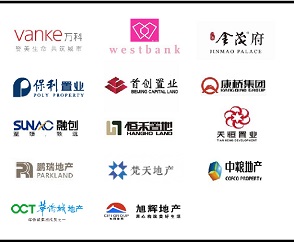Jean Nouvel: 阿布扎比卢浮宫设计/Louvre Abu Dhabi
任何地方的人都喜欢例外的天气。冷的时候喜欢温暖,热的时候又需要凉爽。人们无法忍受急剧升高的温度,艺术品也是一样。这些简单的观察结果对阿布扎比卢浮宫形成了重要影响。它所创造的是一个沉静而亲切的、充满光影和映射的空间。它期望自己属于国家,属于它自身的历史与地理环境,而非某种令人厌倦的、约定俗成的转译或者赘言。它期望展现的是一种别处所没有的迷人魅力。——让·努维尔
All climates like exceptions. Warmer when it is cold. Cooler in the tropics. People do not resist thermal shock well. Nor do works of art. Such elementary observations have influenced the Louvre Abu Dhabi. It wishes to create a welcoming world serenely combining light and shadow, reflection and calm. It wishes to belong to a country, to its history, to its geography without becoming a flat translation, the pleonasm that results in boredom and convention. It also aims at emphasizing the fascination generated by rare encounters. – Jean Nouvel
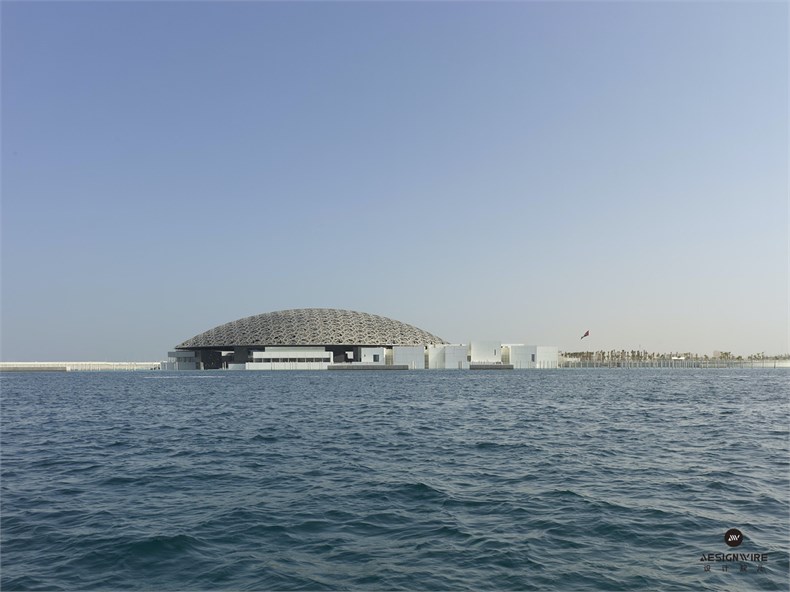
基于传统的阿拉伯建筑文化,普利兹克奖得主让·努维尔为阿布扎比卢浮宫找到了其独有的内涵。通过对场地语境的考量,努维尔将其打造成了一座海洋中的“博物馆之城”。一系列鲜明的白色体量源于麦地那及阿拉伯地势低洼的房屋。这座“城市”共计有55栋独立建筑,其中包含了23间画廊。建筑群的立面由3900块高性能纤维混凝土(UHPC)构成。
Pritzker-prize winning architect Jean Nouvel sought inspiration for the concept of Louvre Abu Dhabi in traditional Arabic architectural culture. Taking a contextual approach to the site, Nouvel designed Louvre Abu Dhabi as a ‘museum city’ in the sea. Its contrasting series of white buildings take inspiration from the medina and low-lying Arab settlements. In total, 55 individual buildings, including 23 galleries, make up this museum city. The façades of the buildings are made up of 3,900 panels of ultra-high performance fibre concrete (UHPC).
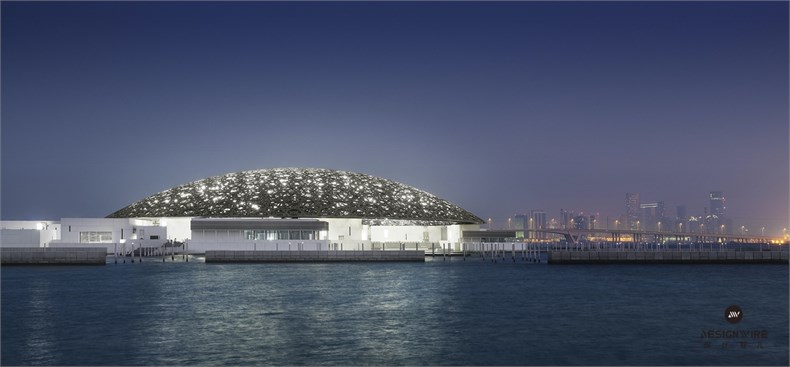
直径达180米的巨大圆形穹顶覆盖了博物馆之城的主体,从海洋、附近区域乃至阿布扎比都可以清楚地看到它的存在。这座穹顶由来自奥地利的专业钢结构公司Waagner Biro建造,包含8层结构:4个不锈钢外层,以及4个铝制内层,并由5米高的钢架进行划分。钢架由10000个结构部件构成,预先装配在85个超大尺寸的结构当中,每个结构重量可达50吨。
A vast dome, 180 metres in diameter, covers the majority of the museum city and is visible from the sea, the surrounding areas and Abu Dhabi city. This dome was constructed by the Austrian company Waagner Biro who specialize in steel structures. The dome consists of eight different layers: four outer layers clad in stainless steel and four inner layers clad in aluminium separated by a steel frame five metres high. The frame is made of 10,000 structural components pre-assembled into 85 super-sized elements, each weighing up to 50 tonnes.
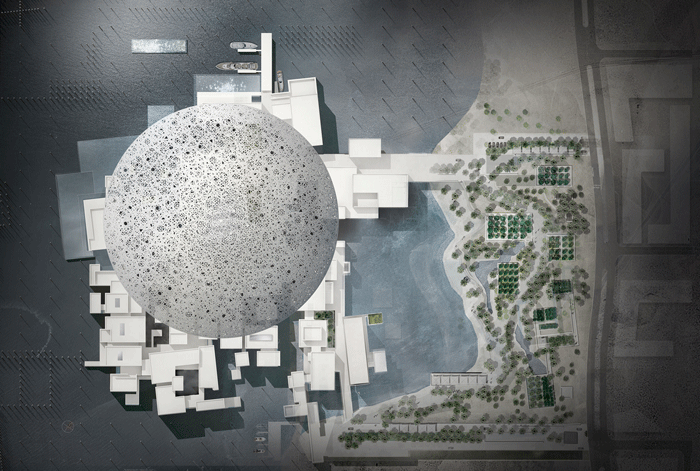
穹顶的复杂纹理以极其深入的几何学研究为基础,在制作期间,让·努维尔工作室的建筑设计团队与BuroHappold Engineering的结构工程师们进行了密切的合作。穹顶上的图案在八个重叠的层面上以多种尺寸和角度重复排布,使射入的每一束光线都必先经过八个层次的过滤,然后逐渐淡出。随着日照路径的变化,穹顶最终呈现出一种梦幻的效果。夜里,穹顶的图案将形成7850颗星星,将室内与室外同时点亮。以“光之雨”为名,这一现象在建造过程中被运用到众多模型和原型之中,同时也成为了设计概念中最典型的特征之一。
The dome’s complex pattern is the result of a highly studied geometric design. It involved close collaboration between the architectural design team at Ateliers Jean Nouvel and the structural engineers at BuroHappold Engineering. The pattern is repeated at various sizes and angles in the eight superimposed layers. Each ray of light must penetrate the eight layers before appearing then disappearing. The result is a cinematic effect as the sun’s path progresses throughout the day. At night, it forms 7,850 stars visible from both inside and out. Named the ‘rain of light’, this effect has been the subject of many models and mock-ups over the years and is one of the defining features of the concept.

整个穹顶只用了4座墩柱进行支撑,每座的间隔为110米。这些墩柱被隐藏在建筑内部,从而使穹顶呈现出漂浮的感觉。从首层地面到室内天花板的底端,穹顶的内部高度为29米。穹顶最高点的海拔为40米,高于首层平面36米。博物馆的设计结合了传统和现代的建造技术。宁静的氛围使参观者得以尽情享受阳光和穹顶,以及海洋、建筑和陆地之间不断变化的关系。复杂的工程设计更让阿布扎比卢浮宫成为当代最具创新性和挑战性的博物馆项目之一。
The dome is supported by only four permanent piers, each 110 metres apart. These are hidden within the museum buildings to give the impression that the dome is floating. The interior dome elevation is 29 metres from the ground floor to the underside of the cladding. The highest point of the dome is 40 metres above sea level and 36 metres above ground floor level. The museum design is a collaboration between traditional design and modern construction techniques. The tranquil environment encourages visitors to enjoy the ever-changing relationship between the sun and the dome and between sea, buildings and land. The complex engineering concept made Louvre Abu Dhabi one of the most innovative and challenging museum projects to be built in recent times.
室内展览空间 | Interior exhibition spaces
室内展览空间共计8600平方米,包含博物馆画廊、临时展览空间以及儿童博物馆。其中博物馆画廊占6400平方米,陈列了大约600件艺术品。儿童博物馆共有2层,约200平方米,是为最年轻的参观者们特别准备的展览区域。
The interior exhibition spaces, comprising museum galleries, temporary exhibition spaces and Children’s Museum, make up 8,600 square metres. The museum galleries incorporate approximately 6,400 square metres and showcase approximately 600 artworks. The two-stories-Children’s Museum completes the ensemble with approximately 200 square metres specially laid out for Louvre Abu Dhabi’s youngest visitors.
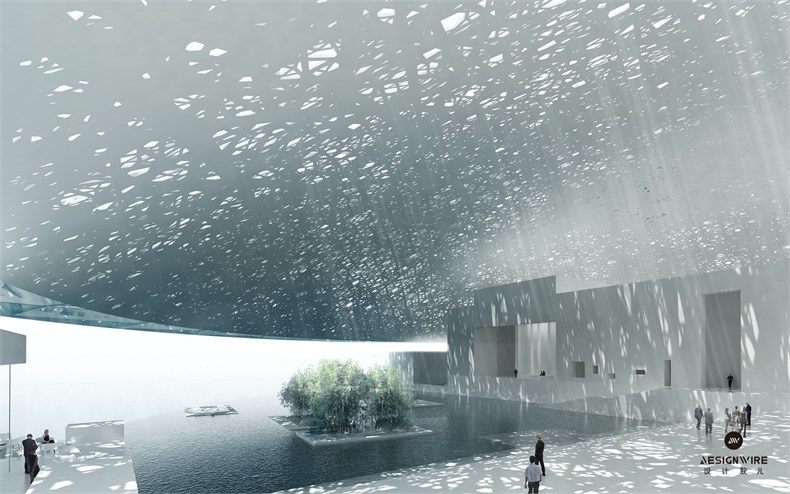
博物馆画廊 | Museum galleries
博物馆画廊的地面、墙壁和屋顶表面皆由让·努维尔工作室专门设计,使阿布扎比卢浮宫的宏伟气度进一步得到加强。地面上铺设着镶有铜制边框的石板,在每间画廊中,石材的选择皆呼应了展品诞生的年代。墙壁则提供了灵活的悬挂系统:所有辅助性的构件皆隐藏在特制的墙壁凹槽之内。
Specially designed by Ateliers Jean Nouvel, the floors, walls and ceiling surfaces of the museum galleries re-enforce the palatial dimensions of Louvre Abu Dhabi. The floor paving is made of stone modules framed in bronze: throughout the galleries, the choice of stone responds to the period of the artworks on show. The walls provide hanging flexibility: all subsidiary equipment may be concealed within special wall slots.
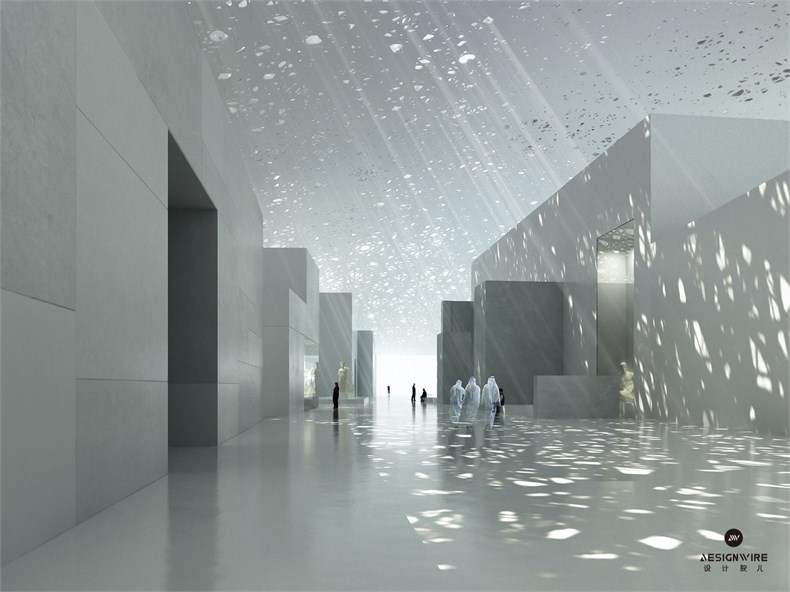
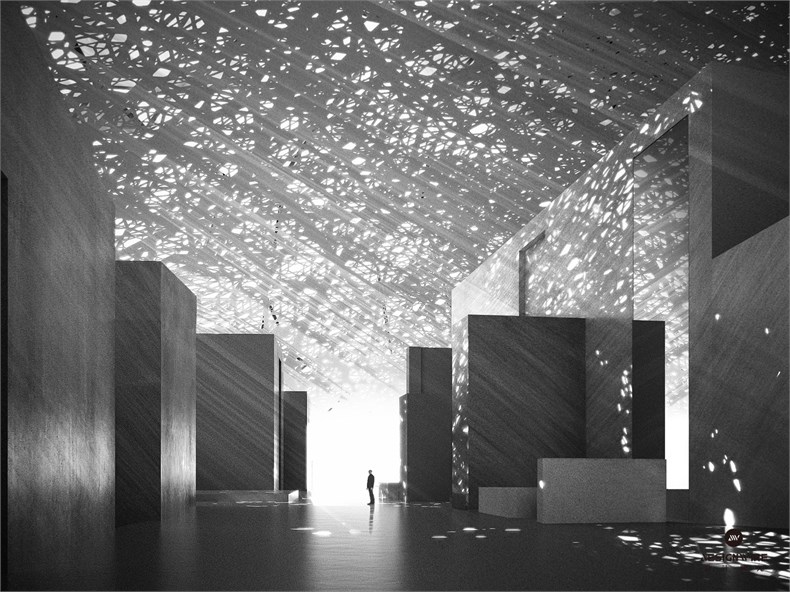
墙面上能够环视周围风景的窗户加上屋顶的天窗,共同使被过滤的自然光充斥着所有的画廊。玻璃镜片的使用将光线捕捉并导向画廊内部,并通过散射避免了刺眼的眩光。画廊内共有17座玻璃屋顶,每座皆是由18种不同的玻璃板构成,共计使用了25000块独立的玻璃板材。玻璃天花板使自然光和人造光融为一体,为展出的艺术品带来最为理想的照明系统。
Filtered natural light can be present in all the galleries, either from lateral windows with views onto the surrounding environment or through zenithal lighting. This involves the use of glass mirrors to capture sunlight and direct it into the gallery spaces while also scattering rays to avoid glare. There are 17 glass ceilings within the museum galleries. Each is made up of 18 different types of glass panels. In total, there are over 25,000 individual pieces of glass. These glass ceilings incorporate both natural and artificial lighting to provide an optimal lighting system for the artworks on display.
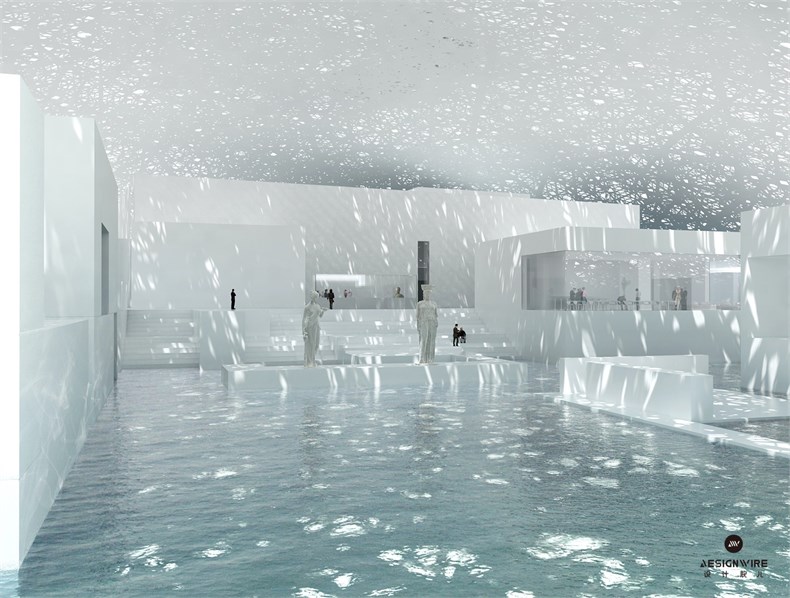
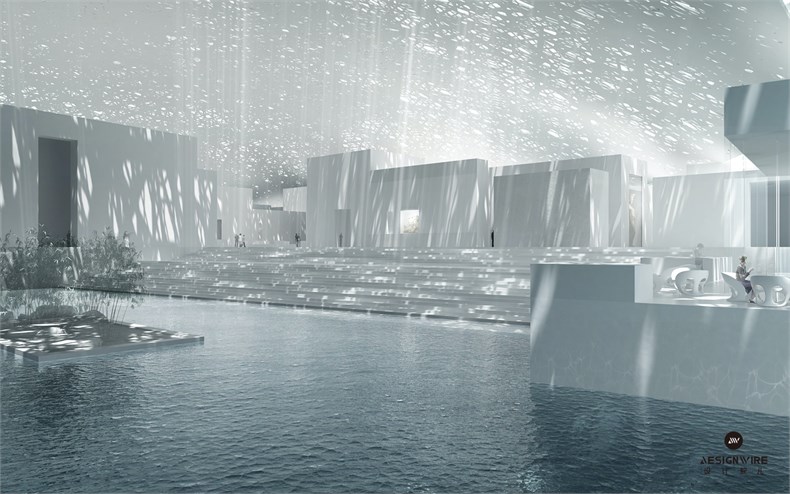
为了满足画廊内部严苛的环境调控需求,设计团队开发出了一套系统,使室温维持在21摄氏度(上下浮动不超过1摄氏度),同时湿度的变化范围不超过5%,从而为艺术品和参观者提供了极为稳定的环境条件。火警探测与抑制系统也经过了精确计算,使艺术品免于收到损害。
To meet stringent environmental control requirements within the museum galleries, the design team developed a system which cannot deviate by more than one degree from 21 degrees centigrade or 5% humidity range. This guarantees exceptionally stable environmental conditions for artworks and visitors. Fire detection and suppression systems within the galleries require special measures in order to avoid damage to the artwork.
环境 | Environmental features
基于建筑的自然形态和材料的固有性能,被动式的设计手法使气候条件得到了进一步改善,最终成功地减少了42%的阳光辐射、27.2%的能源消耗以及27%的用水量。阿布扎比卢浮宫以LEED银级认证为目标,同时得到了阿联酋绿色建筑条例的3珍珠等级。防水系统方面,最初施工基于挖方抽水得以建设,建设完成后水泵停止工作,设置在博物馆四周的水池被灌满海水,博物馆重新漂浮于海面之上。博物馆设计还考虑了海洋极端气候的威胁,设置了多处防波堤,以保护建筑和广场不被风暴袭击。
Passive design techniques use the natural form of buildings and inherent properties of materials to improve climatic conditions. Together, these techniques achieve the following benefits: 42% reduction in solar gain; 27.2% reduction in energy use; 27% reduction in water use; Louvre Abu Dhabi’s design is targeting a LEED Silver rating and has achieved a 3 pearl Estidama Design Rating. At the beginning of the construction process, the museum was built within a dry dock. Construction of the dry dock began with the installation of a rock embankment, technically known as a revetment. This created a new, temporary coastline on the south-west corner of Saadiyat Island, which was then backfilled using sand pumped from the sea bed. Louvre Abu Dhabi is protected from the open sea by approximately 280 marine piles as well as concrete breakwaters, tidal pools and a specially designed ‘wearing wall’ system.
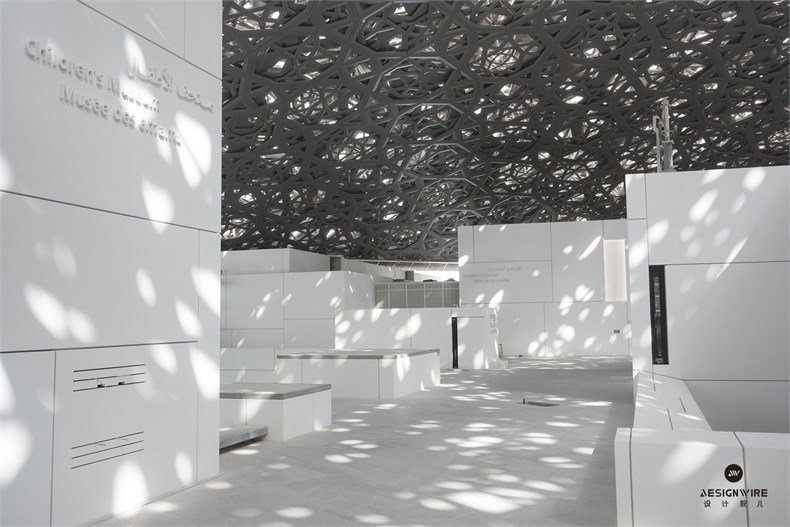
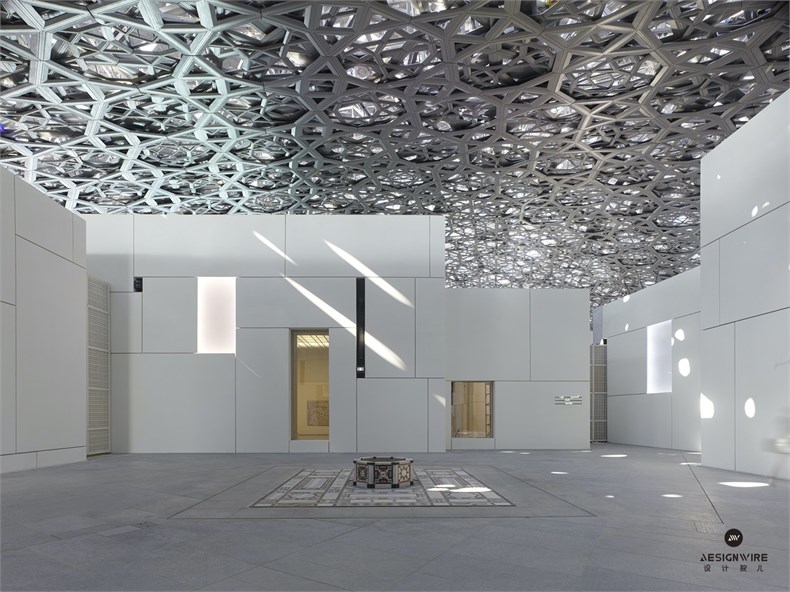
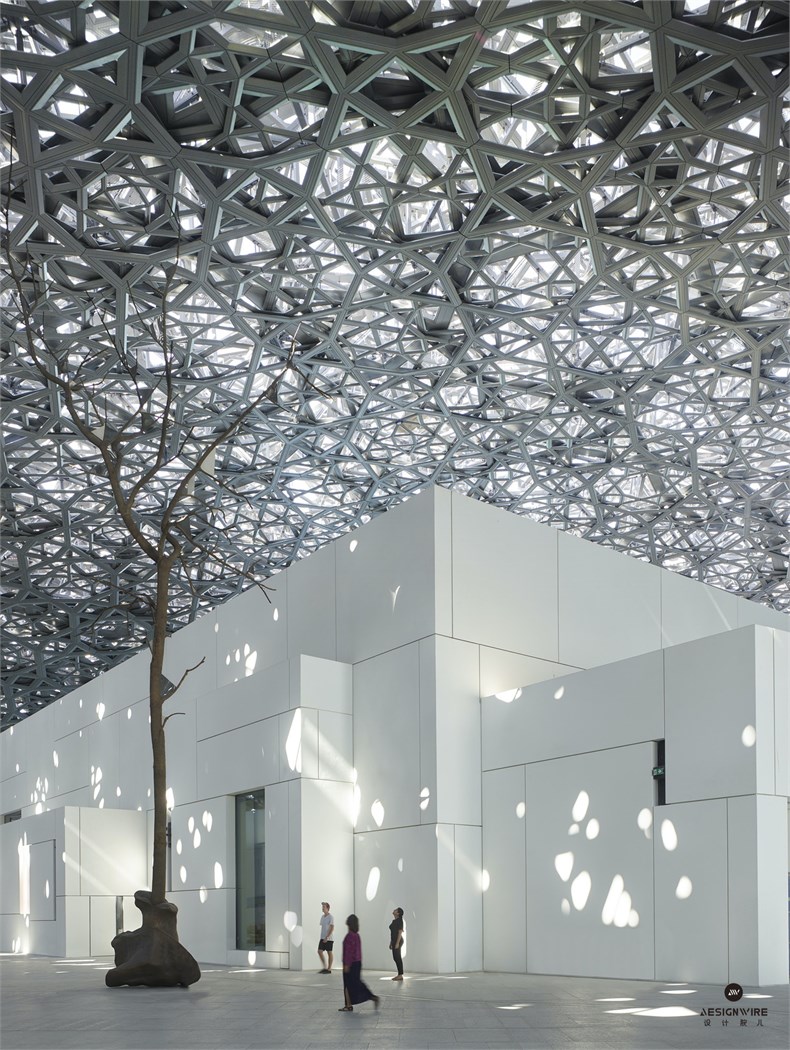

布局图和立面图 plans and sections:
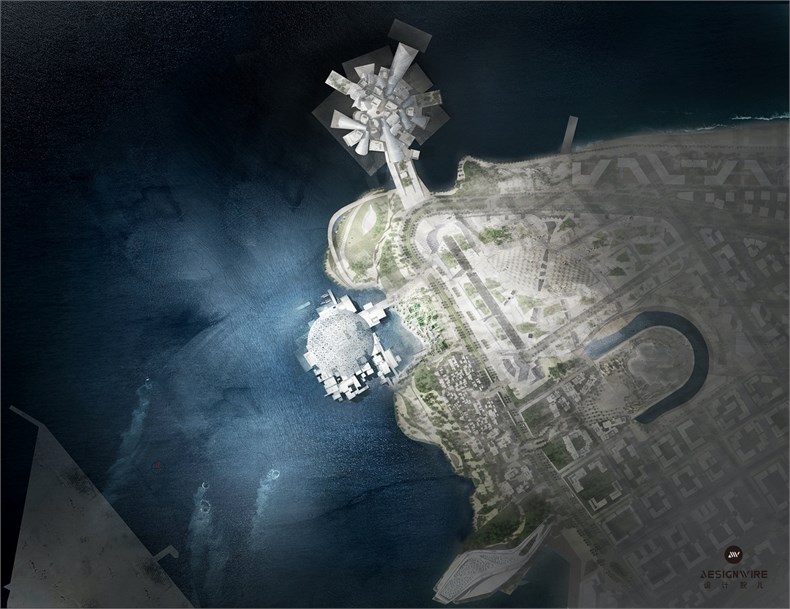
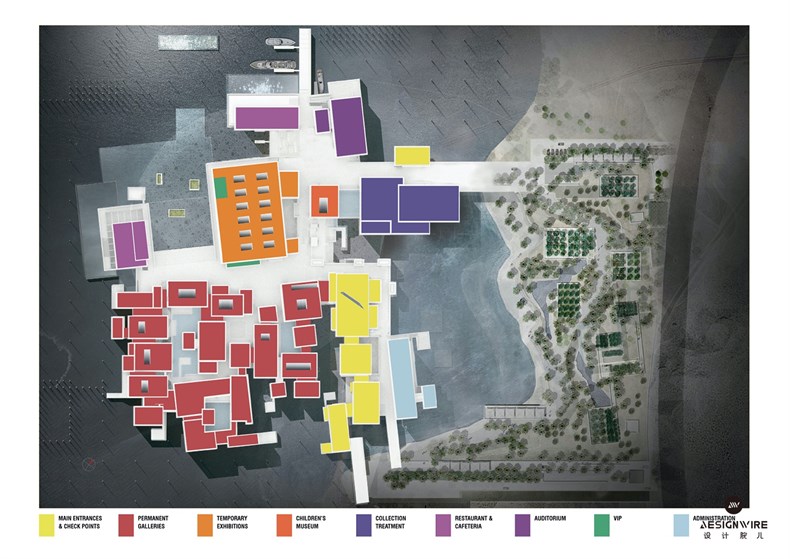
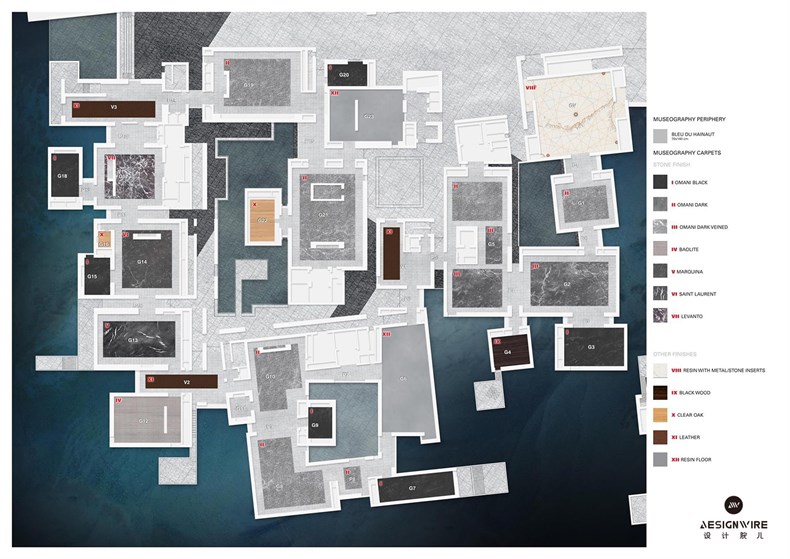
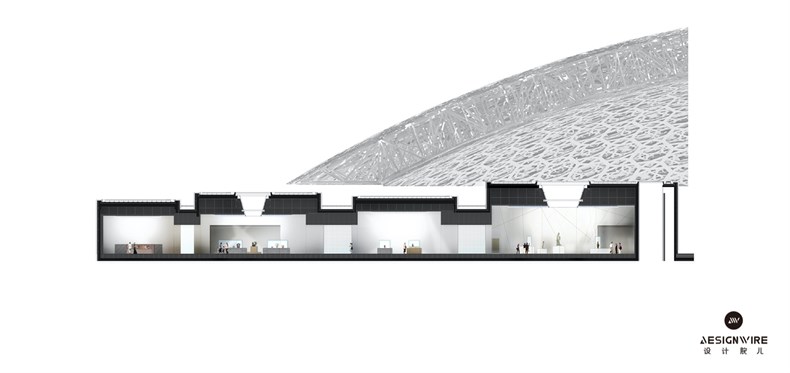
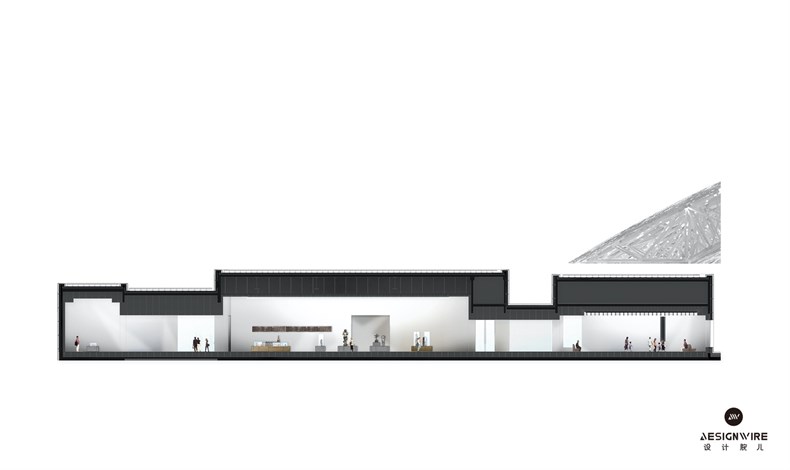
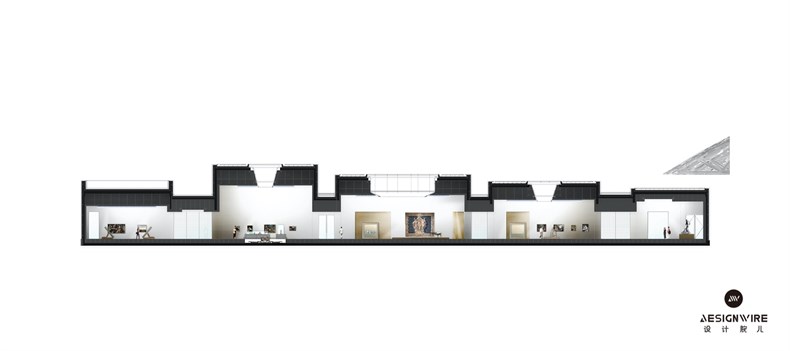
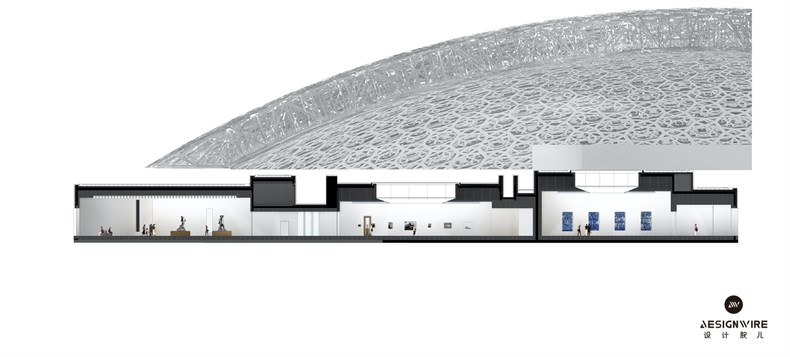

结构图 structures:
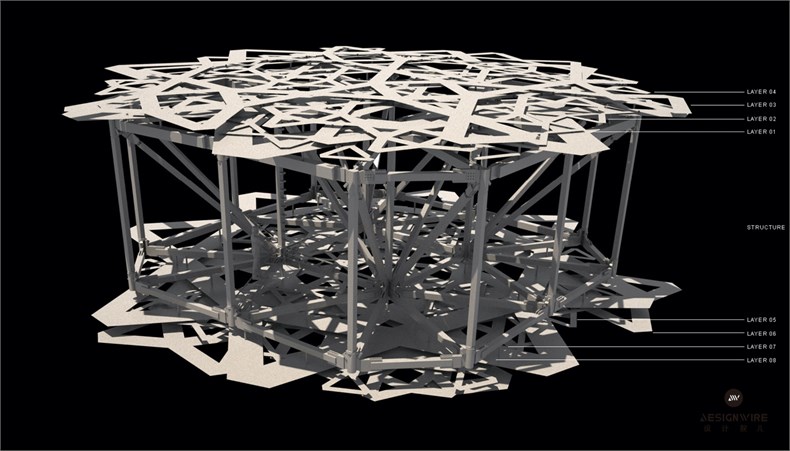

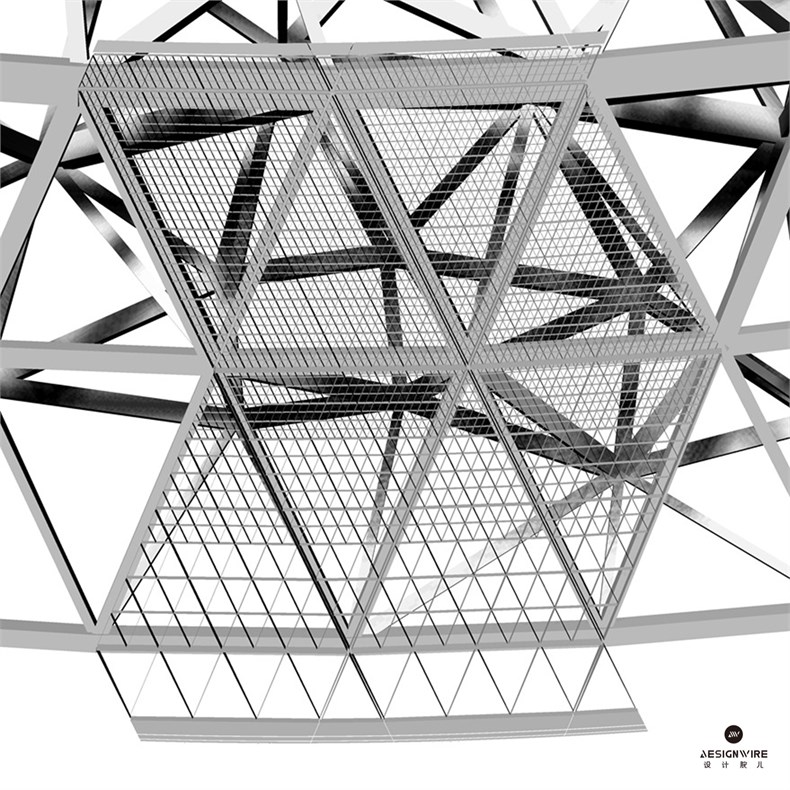
建筑师:Ateliers Jean Nouvel
地址:萨迪亚特文化区, 阿布扎比,阿拉伯联合酋长国
首席建筑师:Ateliers Jean Nouvel
建筑师合伙人:Hala Warde
建筑面积:97000.0 平方米
项目年份:2017年
摄影师:Roland Halbe, Abu Dhabi Tourism & Culture Authority, Fatima Al Shamsi, Mohamed Somji
艺术委员会:Jenny Holzer Giuseppe Penone
项目负责人:Jean-François Bourdet, Anna Ugolini (rchitecture / Interior Design / Museography); Sabrina Letourneur, Frédéric Imbert (Design); Damien Faraut, Athina Faraut (Construction)
高级建筑师:Rolando Rodriguez-Leal, Mireia Sala Font, Anne Traband, Michal Treder, Natalia Wrzask
设计团队:Raphael Renard, Reda Slaoui, Youssef Tohme, Qiang Zou, Stefan Zopp, Kris Geldolf, Roula Akiki, Alessandro Balducci, Jessica Caldi, Camille Dauty, Mark Davis, Stacy Eisenberg, Marion Foucault, Steven Fuhrman, Virginie Heckle, Stéphanie Menem, Abel Patacho, Miguel Reyes, Kathryn Stutts, Jordi Vinyals, Sébastien Yeou, Mariam Abuebeid, Sara Al Sawi, Kelly Anastassiou, Donna Ashraf, Jessica Caldi, Daniella De Almeida, Fay El Mutwalli, Maryam Hosny, Zaina Khayyat, Youmna Najjar
室内设计:Eric Nespoulous / JND
效果图:Artefactory (Eric Anton), Jugulta Le Clerre, Clément Oudin, Raphael Renard
平面设计:Rafaelle Ishkinazi, Marie Maillard, Léo Grunstein, Clovis Vallois
工程师:ARUP (Concept Design); BuroHappold, Transsolar (Schematic Design); Andrew Snalune (Façades); BuroHappold (Construction)
博物馆技术学:Renaud Pierard
标识:Philippe Apeloig, Kristian Sarkis
照明设计:8’18”
透视法、多媒体:dUCKS scéno
景观设计:Michel Desvigne, Jean-Claude Hardy
音响效果:Studio DAP
成本顾问:MDA Consulting
抗震设计:Setec
模型制作:Jean-Louis Courtois
Edit by Designwire

